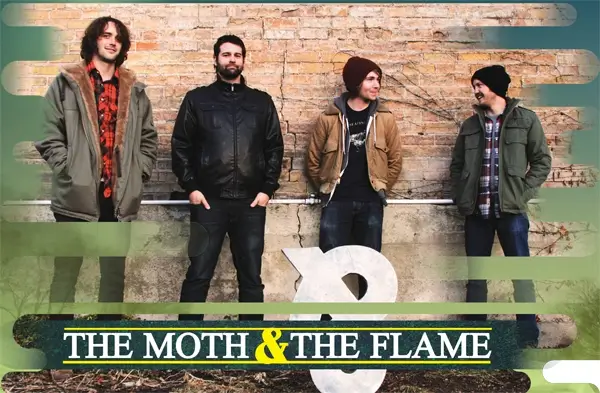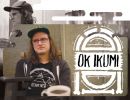Localized – Wake Up Nebula, OK Ikumi and The Moth & The Flame
Localized
It’s going to be an unforgettable night of local music at the Urban Lounge on March 9. Localized, this month, features Provo darlings and indie art rockers The Moth & The Flame, and the mellow electro samplings of OK Ikumi. Get there early to catch the ethereal soundscapes of electro-pop band Wake Up Nebula for only $5.
The Moth & The Flame
Mark Garbett – Keys/Vocals
Nate Pyfer – Programming
Brandon Robbins – Vocals/Guitar
Andrew Tolman – Drums
From dreamy acoustic lullabies to crashing cymbals and dramatic yelps, The Moth & The Flame contain a wide berth of emotion in their debut, self-titled album, all fused together with the deep grumbling of Brandon Robbins’ sultry voice. When I met with the four-piece, I was only expecting the two founding members, Robbins and Mark Garbett. Andrew Tolman and Nate Pyfer were added to the lineup only a few months ago, but it was a pleasant surprise, as the bandmates were only too happy to share the spotlight and were equally as enthusiastic about the band’s music.
Velour, one of Provo’s most illustrious music venues, gets the birthing credit for The Moth & The Flame two years ago. Bandmates in Robbins’ brother’s local band, Somber Party, Robbins and Garbett started writing their own material in Garbett’s tiny basement. Corey Fox, Velour’s owner, booked the two for a last-minute set one night in Nov. 2010, also calling on Pyfer to fill in on the sound board. “These guys get up and had really terrible equipment, and sound guys are really bad about judging bands by their gear, so I’m thinking, ‘Oh, these guys are gonna be a joke,’” says Pyfer.
Even with Robbins mumbling through the unfinished songs, Pyfer heard the potential in the band that night and immediately offered up his talents to produce TM&TF’s first album. The duo officially became a trio about two months ago, when Pyfer was absorbed into the ranks to take care of all the programming and “weird sounds.”
Tolman joined the group soon after as the drummer (Aaron Anderson of Fictionist drummed on the album), directed to TM&TF by Fox after leaving his latest musical venture, Magic Dragons. The new additions double the band’s talent, and allow for a more full-bodied live show. “We’re all committed to making sure the album is very well represented,” says Pyfer. “If it’s on the record, I want to find a way to do it live.”
Describing their music, Robbins says, is always difficult. After throwing around a few different terms, the band members agree that “art rock” accurately encompasses their sound—“Moth rock,” jokes Garbett. “It’s kind of like The National meets Radiohead,” says Tolman. “That’s the picture that I’ve always gotten.” Robbins describes his musical inspiration for the record as a “melting pot” of influences that range from the obvious—Radiohead and Beck—to the more subtle Pearl Jam and Sparklehorse.
The term “art rock” doesn’t just describe their music. The band is selling their debut album exclusively in physical form—no digital tracks available for purchase, though you can stream it from their Soundcloud—stating on their website, “We’ve decided that the only way we want to present this album, for the time being, is in its physical form because of how important the art is to the album. The art was not an afterthought, but rather an integral part of the process, and we consider it to be the opening track of the album.”
Robbins and Garbett were struck by the photograph on the cover—a man held up by crutches in a desert landscape—the work of New York collaborative photography duo Kahn & Selesnick, before they even started the recording process. The song “How We Woke Up” was actually inspired by the artwork, Robbins says. The band also collaborated with a few artist friends for their CD-release party back in November, creating anthropomorphic giants and placing them as temporary art installations around Provo prior to the show. The giants, including a creature 20-feet tall, were then placed at the front of Velour to greet people as they walked inside. “As a band, we’re focused on the visuals very heavily,” says Garbett. “For me, it’s also a statement that we’re art rock.”
The Moth & The Flame have seen some decent success and popularity in Utah and the surrounding areas, along with a healthy dose of love from music blogs around the world. They set out on their first West Coast tour this March, which they anticipate will go well. “Everyone’s decided to do what we need to do to make a career in music, and that’s what we’re going to work for, and go about it the best way we know how,” says Tolman.
If for any reason their bright musical futures fail them, they’ve got a Plan B: “Professional basketball players [on the Velour Girls basketball team],” says Pyfer. Catch The Moth & The Flame before they slam dunk at Localized on March 9 at Urban Lounge.
OK Ikumi
Karl Jørgensen – Everything
I was immediately drawn to OK Ikumi before I’d heard a single note of Karl Jørgensen’s Orem-based, one-man electro project. Perhaps it was the playful and “aesthetically pleasing” name, which Jørgensen found last minute via text message before his first show at Kilby in 2004. Maybe it was the simple yet nostalgic illustrations he designs for his album artwork, ranging from sleeping cats to scenes out of a sci-fi novel.
Whatever the appeal, it became clear we were meant to be when I finally pressed play. Starting my interview with Jørgensen believing any music containing a synth could be dubbed “electro,” I left with a better understanding of the genre than anyone has ever been able to convey to me, along with a list of bands and projects to check out thanks to Jørgensen’s extensive musical knowledge and passion.
SLUG: How did you get started making music?
Jørgensen: When I was a kid, I wanted a keyboard … It took a few years of asking my parents, but I finally got a terrible one. I grew up listening to straight punk music without any other social input, really. I didn’t listen to [electro] at all until I was 18, but I was making [4-track recordings] before then.
SLUG: I’ve always categorized everything with a synth under “electro.” Why is that wrong?
Jørgensen: You wouldn’t lump together things that have guitars and drums as the only thing they have in common—that’s how I feel about the electronic world as well. There are so many styles and moods—it’s not all sterile or energetic.
SLUG: So how would you describe OK Ikumi’s music?
Jørgensen: I’m aiming for a subtle mood or atmosphere. It’s not something that people generally respond strongly towards. When I try to do shows now, I just want to create this atmosphere of pleasantness and non-confrontation, a nice feeling that you can get caught up in that isn’t forceful.
SLUG: It seems you like themed and/or structured projects, i.e.: Your 12/10 EP was an attempt to write a song every day for the month of December 2010, IV/XI was inspired by Arthur C. Clarke’s Space Odyssey…
Jørgensen: I feel like the limitations are beneficial to creativity. I feel like the more limitations, the better. I’m currently working on a procedurally generated system to make songs entirely without my input. When you’re working in the electronic medium, it can be kind of overwhelming since you can make pretty much anything. When I started making electronic music, in the mid- to late-’90s, I used this pretty awful freeware recording and drum loop software that was extremely limiting, so I feel like it helps you to push barriers a little when there’s barriers there. With other projects, I don’t use those. Sometimes it works, and it’s beneficial, but it’s not something that I all-the-time believe in.
SLUG: You’ve taken OK Ikumi nearly everywhere, from West Coast tours, to a 2008 tour in Japan and your latest 2010 tour in Montreal. What’s next?
Jørgensen: I haven’t played any shows on the West Coast since 2007 … If you’re making indie rock or singer/songwriter stuff, there’s a built-in network to work with, but that doesn’t really exist in most cities for my style of music, so it makes touring a little bit harder.
SLUG: You’ve only had one label release through Blue Bell Records, your only OK Ikumi full-length, 2007’s Spirits. Now you’re working on your own label, Hel. Tell me more about that.
Jørgensen: I like coming across labels that I like because it’s like you’re discovering a network. Right now, it’s so easy to release and distribute music because of the Internet, but it’s so chaotic. So I feel like if you’re making a weird type of music, little labels can really help organize. I want to catalog things I like and also release stuff of mine.
SLUG: What’s some good stuff you’ve been listening to lately?
Jørgensen: I’ve been actively trying to diversify what I listen to. If I don’t like something, I’ll try again in a year to see if I like it. It’s good to like stuff, there’s more for you to listen to. I’ve been into this Nigerian ’70s music lately, it’s kind of funk-type stuff, but it’s very raw, and has this spacey kind of element to it. There’s a band called SJOB Movement that’s great. That’s the biggest thing you can do to improve your musical skill, is to improve your musical taste. It improves the brain filtering process.
SLUG: Five-year plan for OK Ikumi?
Jørgensen: No plans, no goals, as long as I’m inspired. There’s always new territory to explore, to keep exploring.
Get a taste of OK Ikumi for yourself at Localized on March 9 at Urban Lounge.


